|
|
J.J. Maher: The Flat Racers

|
|
|
|
| In close to thirty years of breeding thoroughbreds for flat racing, J.J. Maher bred four winners of the so-called Classic Races in Great Britain, and many other good racehorses, a number of which were close-in ancestors of additional classic winners. He primarily bred for the annual Tattersall's Doncaster and Newmarket yearling sales in the fall. The horses he sent to the flat races as an owner-breeder were not trained by him, and almost all of them were fillies he had earmarked for retention in the Confey Stud; most only raced at age 2, sometimes, if they ran well, at age 3, and few showed on the racecourse anything near to what they would ultimately achieve at the stud. He seldom kept more than six broodmares at any one time, making his successes all the more worthy of examination. |
|
Maher started breeding horses for the flat in 1905, and sent his first youngsters to the Doncaster sales in 1907, the year he bought Confey Stud in County Dublin, and hired Tom Beeldestone, who had worked at the famous Eaton Stud, as stud groom. He leased the stallion Llangibby (1902, Wildfowler-Concussion by Reverberation) to stand at Confey and service some of his mares, although he also used outside, and usually superior, stallions. Llangibby was a moderately succesful racehorse, winner of the Eclipse Stakes and several other races, and was third in the 2,000 Guineas Stakes. If we know his name at all today, it is because he got Wenchel (1915 from Princess Sterling) for Maher, whose daughter, Callista (by Phalaris) bred on, and more significantly he got Maher-bred Golden Harp (1914, from Goldscleugh), who is in the pedigrees of Royal Minstrel, Qurrat-Al-Ain, and Melpomene (all bred by Maher), the ancestress of the American racehorse Needles.
None of Maher's youngsters sold for over 1,000 guineas until 1912, when Carbon (a non-winner, 1911, by Llangibby - Gem Gem) brought 1,850 guineas, his first four-figure breakthrough. He continued breeding horses throughout World War I, supervising his operation on periodic visits home from North America, where he was serving as a buyer for the Remount Commission. But sales were poor, though stud fees for the best stallions, he complained, were not being reduced to accomodate hard-hit small breeders. He had several youngsters break the four-figure barrier during those years, but the only one who could be considered successful was Menin (1915, Roi Herode - Saindoux by Sainfoin), who sold for 1,700 guineas and went to Australia, where he won some races.
In the mid teens Maher brought the 2,000 Guineas winner Louvois (1910, Isinglass - St. Louvaine by Wolf's Crag) to Confey to use with his mares. Louvois had been a good winner at ages 2 and 3, and was runner-up in the Derby Stakes, and his brother, Louviers, was also a stakes winner. It was he who sired the second of the Maher-bred classic winners, St. Louis (1919, from Princess Sterling), and also Harpsichord (from Golden Harp), one of the few fillies Maher retained for Confey who was a good racehorse, the dam of Royal Minstrel and Qurrat-Al-Ain.
By the early '20s Maher had decided that standing his own stallions was interfering with his ability to make sound breeding decisions regarding his mares, and he got rid of them, resolving to use that freedom to breed to the best stallions for his mares, many already second or third generation bred at Confey. From that point on he was almost always at or near the top of the best thoroughbred breeders in Great Britain, both in money won by runners he bred, and in annual yearling sales. In the six years prior to 1918 he sold 36 yearlings at an average of 486 guineas at Doncaster and Newmarket; in the years between 1919 and 1934 he sold 78 yearlings for an average price of 2,694 guineas.
|
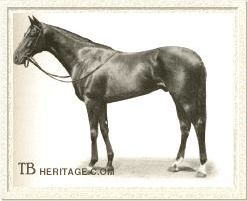
Louvois stood at Confey in the late teens, and got 2,000 Guineas winner St. Louis, Maher's second classic winner.
| | 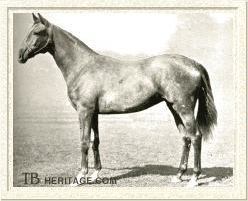
Likened to Mumtaz Mahal at the Doncaster sales, where she brought a record-breaking price, Fête, by Tetratema, did nothing on the track, or in the stud.
|
As the years went on, Maher was increasingly successful in his sales, with periodic sales-toppers, and often one or more in the top ten, out of more than one or two hundred yearlings sold at Doncaster or Newmarket, and he was frequently at or near the top in the list of average sales prices. The high point was 1928, when he sold just three yearlings, at an average price of 9,166 guineas (Qurrat-al-Ain, Algonquin, and Mannite; Qurrat-al-Ain came closest to making back her purchase price on the track, winning £11,092). Some of his yearlings, such as Fête (1924, Tetratema-Confey by Polymelus) sold very high--Sir Victor Sassoon paid the record breaking price of 12,000 guineas for her, creating a sensation at Doncaster in 1925 -- and never made a cent for their owners on the track, and did nothing of note in the stud. Some, such as Manna (1922, Phalaris - Waffles by Buckwheat), sold well -- 6,300 guineas to H.E. Morriss, second highest price of the 1923 Doncaster sales -- and repaid their owners many times over, both on the turf (Manna won £26,228) and in the stud. Overall, however, the horses he bred were winners, some very good ones, and many of the fillies went on to have an influence on the breed as a whole; horses bred at Confey during Maher's lifetime, about six each year between 1912 and 1934, together won over £100,000, and realized much more in yearling sales prices.
It should be stressed that Maher bred winners andwas high on the list of prices realized from the sales of yearlings for most of the 1920s and early '30s, and all this from very few broodmares--there were seldom more than five yearlings sold from Confey each year, and frequently less. In 1923 four horses Maher bred won nine races with a total value of £2,603; the total earnings of Maher-bred winners after that time never fell below that level in his lifetime. In 1925 Maher was listed as third in Great Britain's list of Breeders of Winners (ranked by money won), with four winners that had won £24,942, Manna's Derby and 2,000 Guineas wins contributing significantly to his ranking. The following year he barely missed the top ten breeders, with five winners of twelve races worth £6,281. In 1931 Maher was sixth in the list, just behind Lord Derby, and ahead of the Aga Khan, the National Stud and other top breeders, with six winners of twelve races worth £21,351. That was St. Leger winner Sandwich's year, with the Maher-bred Irish 1,000 Guineas winner Spiral contributing. Second in the list that year, incidentally, was the entire country of France, all French-breds being lumped together as winners of 70 British races with a total value of £32,879; eleventh were all winners of British races bred in the U.S.
The Tale of N.R.A. and Snoot
N.R.A., an unpromising filly of 1902 by Deuce of Clubs (1883, by Robert the Devil) out of Miss Gunning (1890, by Petronel), from a female line that had produced nothing of significance on the track except the very moderate stakes placed Heir Male (1895, Aryshire-Maylie by Isonomy) came up for sale at Newmarket in 1905, in foal to Perigord (1890) a not particularly successful sire son of St. Simon's.
Maher was still at ringside, purportedly disappointed over having failed on the bidding of a mare he fancied, and viewed the new weedy lot with "contempt." The story goes that Maher, gazing at N.R.A., suddenly was seized with a notion that might prove the worth of his recently purchased Confey Stud land, rich in limestone, by breeding horses of size and substance from a mare "...that had neither." So he bought N.R.A. for 90 guineas.
In 1906 the small Perigord filly, Snoot, was born. Considered useless for racing, Maher kept her, presumably for his experiment. In the stud, Snoot produced ten yearlings that sold for a total of 12,800 guineas, most of them small, but, it was claimed, all with good bone. Five of her foals were winners, and three of these, fillies, were good producers. Her best foals included the unraced Lady Comfey (1913, by Roi Herode); Snow Maiden (1916, by The Tetrarch), winner of the Irish Oaks, and the first youngster to indicate her sire, The Tetrarch could produce horses that could stay; her brother, Caligula (1917, by The Tetrarch), Maher's first classic winner (St. Leger), who later proved to be almost impotent at stud in Germany; and Eagle Snipe (1920, by White Eagle), who won some races for her purchaser, the Aga Khan, and later produced some good racehorses and was the grandam of classic winners in France and Ireland. |
| N.R.A. 1902 by Deuce of Clubs, Family 7 |
| SNOOT 1906 by Perigord |
| LADY COMFEY 1913 by Roi Herode |
AMOURETTE 1918 by Prince Palatine
Grandam of Noble Star |
AMERICAN FLAG 1922 by Man O' War
Belmont, Withers and Dwyer Stakes; sire |
EXALTED 1925 by High Time
Ancestress of Jim French, Nothirdchance |
SNOW MAIDEN 1916 by The Tetrarch
Irish Oaks, Baldoyle Derby |
FANCIULLA D'ANZIO 1925 by Buchan
Sold to Italy as yearling for 6,600 guineas |
SNOW STORM 1926 by Buchan
Ancestress of Frascati |
CALIGULA 1917 by The Tetrarch
St. Leger, Ascot Derby |
EAGLE SNIPE 1920 by White Eagle
minor plate winner; producer |
LE PHARE 1926 by Phalaris
Sussex Stakes, Stewards Cup; sire |
TURTLE SOUP 1928 by Tetratema
Stakes winner at 2; grandam Do Well, Sandjar |
|
Bold type indicates the horse was bred by J.J. Maher.
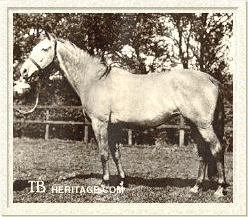
Snow Maiden, winner of the Irish Oaks and the Baldoyle Derby, among other races, along with her St. Leger-winning brother, Caligula, justified Maher's impulse purchase of N.R.A.
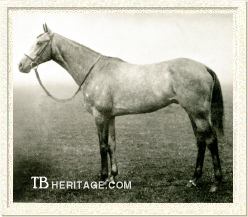
Lady Comfey's second classic winner, Caligula, a brother to Snow Maiden.
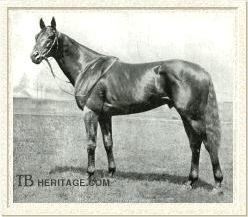
Top U.S. 3 year old American Flag was the son of Maher-bred Lady Comfey, a grandaughter of the weedy N.R.A.
| |
Lady Comfey was sold and imported into America and entered Samuel Riddle's stud, Faraway Farm, where she was bred to Man O' War, producing one of the best of his famous sire's first crop, American Flag. He was the leading 3 year old of 1925, but broke down after his Dwyer Stakes win, where he beat Dangerous by six lengths while giving him 14 pounds. Retired to the same stud as his sire, some claim that reduced his opportunity for top mares. Still, he got Gusto, winner of the American Derby and the Jockey Club Gold Cup at age 3, and Nellie Flag, the top 2 year old American filly of 1934 and a good producer. He also sired Lady Glory, grandam of Raise a Native, and therefore in the pedigree of the highly successful sire, Mr. Prospector. Like their sire, both Gusto and Nellie Flag failed to race beyond the age of 3. Lady Comfey also foaled Amourette (great granddam of Prix de l'Arc de Triomphe winner La Sorellina (1950, by Sayani) and Exalted, both good producers.
Snow Maiden, whom Maher retained to race and breed, proved to be a very good race filly, winning the Greer Plate in her only start at 2, and five of her nine starts at 3, placing second three times. Her successes included the Irish Oaks Stakes, the Mountjoy Plate and the Baldoyle Derby, winning decisively each time. Retired to the stud she got two daughters who bred fair winners: Fanciulla d'Anzio and Snow Storm. Three of her yearlings brought Maher a total of 12,800 guineas at the sales, including the grey filly Fancuilla d'Anzio, who was purchased by Federico Tesio for 6,600 guineas--more than twice the average price for other foals by her sire, Buchan-- at the Newmarket second July sale.
Caligula (1917), a brother to Snow Maiden, was purchased by Lord Wilton, and was not run at age 2. At age 3 the grey colt did not place in the 2,000 Guineas, but won the Ascot Derby Stakes (1 and 1/2 miles), beating Abbot's Trace. He was sold just prior to the St. Leger to M. Goculdas, an Indian, for 8,000 guineas. Starting at long odds for the St. Leger, having lost his previous three races, he outstayed the others, including Silvern and Spion Kop. After his wins, he was shipped to India so his owner, who, it was said, for religious reasons could not "cross water," could inspect him. He ran there once, then was returned to England in the fall of 1921. He stood at stud in England at Litchfield Grand Stud Farm in HANTS for a fee of 98 sovereigns, and got a few foals; Snow Marten, the Oaks winner, was bred to him prior to her shipment to France in 1923. He was offered for sale at the Newmarket December sales of 1923, but was not sold at his reserve of 7500 guineas. He eventually was sold to Germany, where he became increasingly infertile.
Eagle Snipe was by White Eagle, a moderate racehorse and a third-rate sire who had been bred by Hall Walker, who in 1916 gifted all his thoroughbreds and his Tully stud to the British government. White Eagle (1905, by Gallinule) was inbred 2 x 3 to Isonomy, and it was his daughters who produced some spectacular horses, including Blanche (dam of Blandford) and Dolabella (dam of Myrobella, by Tetratema, champion sprinter and top 2 year old filly, who later produced Big Game). Eagle Snipe was purchased by the Aga Khan, and won a maiden plate at Hurst at age 3 and placed in several other modest races before retiring to stud. Like other White Eagle daughters, she was a good producer. Her son, Le Phare (1926, by Phalaris) won £6,151, with four wins, two places and three thirds in his fifteen starts at ages 2 and 3. He got a moderately good filly, Peaceful Light, but died after only a few seasons at stud. Eagle Snipe's daughter, Turtle Soup (1928, by Tetratema), won £3,460, and in the stud became the granddam of Sandjar (1944, Goya-Zulaikhaa, winner of the 1947 French Derby), Do Well (1948, Rosewell-Dasaratha, winner of the Irish St. Leger), and Do Well's sister, Nashua (Irish 1000 Guineas winner).
|
The Tale of Princess Sterling
The tale of Princess Sterling's acquisition is as follows. Princess Sterling was sired by Florizel II, out of a Friar's Balsam mare, Sterling Balm. Her breeder, Major Joicey, died before she could race, and at the age of two, in February of 1912, she was offered for sale at a jumper meeting at Kempton Park. Maher planned to purchase her, stopping in London for a stay before going to the sale, where he ran a fellow horseman, who told Maher hewas planning to go to Kempton to buy Princess Sterling. They decided that, rather than bid against each other, they would toss a coin to determine who would get the opportunity to purchase her. Maher won the toss and subsequently obtained Princess Sterling for 510 guineas. She was sent to Atty Persse, Maher's former jump jockey and long-time associate (trainer of The Tetrarch and others), for training in England, where she won a small race; Maher's bet on her win in that race recovered her purchase price. Not showing much more promise, she was put into the stud at the end of the season.
Unlike Snoot, Princess Sterling's pedigree was solid. Florizel II, a son of leading sire St. Simon, was full brother to two top racehorses, Persimmon (also three times leading sire in Great Britain) and Diamond Jubilee, and had himself proved to be a top racehorse, winner of the Prince of Wales' Stakes, the St. James' Palace Stakes, the Ascot Gold Cup and the Goodwood Cup. Princess Sterling's dam, Sterling Balm (1899), was a very good race filly, near the top of her generation at age 2, having won the Gimcrack Stakes and the Coventry Stakes, and at three a winner of the Fern Hill Stakes at Ascot. In the stud Sterling Balm also produced Queen Silver, the dam of 1,000 Guineas winner Silver Urn and Kempton Park Jubilee winner Silver Image. Sterling Balm's dam, Yesterling (1889, by Sterling), was also a winner, and a producer of stakes winners.
|
| STERLING BALM 1899 by Friar's Balsam. Fam. 14 |
| PRINCESS STERLING 1910 by Florizel II |
WENCHAL 1915 By Llangibby
Producer |
SILVER QUEEN 1918 by The Tetrarch
Blake Plate; producer |
SILVER WEDDING 1925 By Bachelor's Double
Sold to Lord Carnarvon 1926, 3,100 gs; producer |
SILVER MIST 1926 By Craig An Eran
Unraced; producer |
SUN MIST 1930 by Soldennis
Modest winner; ancestress Nobless, Saritamer |
MEADOW 1936 by Fairway
Ascot New Stakes and others; sire |
SOL ORIENS 1938 by Hyperion
Irish Derby, runner-up Irish St. Leger; sire |
TYRANT'S QUEEN 1928 By Phalaris
Ancestress of Green Grass (Japanese St. Leger) |
ARGENTINA 1930 By Phalaris
Producer |
ST. LOUIS 1919 by Louvois
2,000 Guineas; sire |
|
Bold type indicates the horse was bred by J.J. Maher.
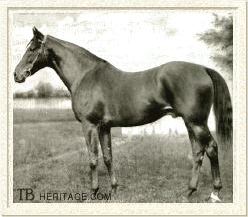
St. Louis won the 1922 2,000 Guineas Stakes, making him the second classic winner bred by J.J. Maher.
| |
In comparison with the more plebian Snoot, Princess Sterling's immediate progeny were not as successful; her only decent racing foal was St. Louis, who managed to win the 2,000 Guineas Stakes, the second classic winner to be bred by Maher. He was by the 2,000 Guineas winner Louvois (by Isinglass), whom Maher stood at Confey for a few years, before deciding standing his own stallions was affecting his judgement on breeding decisions for his mares. St. Louis, a strong and heavy colt, was sold as a yearling to Lord Queenborough for 2,600 guineas, and ran once, unsuccessfully, at age 2. In St. Louis' Guineas race, he upset the favored (and superior) Captain Cuttle. In the Derby, St. Louis ran fourth, seven lengths behind the winner, Captain Cuttle. He ran once more that year, winning the Wolverhampton Breeder's Foal Plate, and was beaten in his only race at age 4. When put under the hammer in 1923, in the same sale that Snoot's Caligula was also put up for auction (at 7,500 guineas) he failed to meet his reserve price of 4,200 guineas. He was put to stud at the Queenborough Snarehill Stud in Norfolk for a fee of 48 sovereigns, where he got nothing of note.
Princess Sterling's daughters were more successful in the stud. Maher retained two of her daughters, Wenchal (1915, by Llangibby, another stallion Maher briefly stood at Confey, leased from Ludwig Neumann) and Silver Queen (1918, by The Tetrarch, the stallion with whom Maher had such success with Snoot's offspring). Later Maher kept a Silver Queen daughter, Silver Mist (1926, by Craig An Eran), from whom he bred good horses. Maher sold four yearlings, including St. Louis, from Princess Sterling, realizing a total of 6,905 guineas for them. With her daughters to hand, he then sold Princess Sterling for 2,500 guineas to the British Bloodstock Agency, and she eventually was sent to the U.S.A.
Wenchal won a small race and tied in another at the age of 2. She went on to produce a series of moderate racehorses, the best being Kerloch (by Swynford); a daughter, Callista (1922, by The Tetrarch) bred on. Maher retained Callista's daughter, Calendula (1926, by Bachelor's Double), for his stud, and she, in turn was grandam of the French-bred stakes winner Flushing II, seen in the pedigrees of horses like Petit Ile (1986, by Ile de Bourbon), Cherokee Colony (1985, by Pleasant Colony), Upper Case (1969, by Round Table), Unbridled's Song (1993, by Unbridled), and other more recent top racehorses. Maher sold a Wenchal filly, Impala, by Phalaris, for 5,200 guineas.
|
Silver Queen, who won the Blake Plate at age 2, and two more small races at age 3, produced four winners, but it was her unraced filly, retained by Maher for the Confey Stud, Silver Mist (1926, by Craig An Eran) who got some solid racehorses, such as sons Meadow (winner of £3,937, including Ascot New Stakes) and Sol Oriens (winner of £3,070, including Irish Derby), and her daughter, Sun Mist (1930, Soldennis), is seen in the pedigrees of such winners as Noblesse, Rainbow Quest, and Saritamer. Mannite, a colt out of Silver Queen, by Manna, sold to Sir Richard Garton for 6,000 guineas; he won only one race, worth £128, and Silver Wedding, her 1925 filly by Bachelor's Double, sold for 3,100 guineas.
The Tale of Golden Harp and Harpsichord
Maher purchased Goldscleugh, another Florizel II daughter, from Model Queen by Lord Lorne, who won two moderate races at age 2 and did nothing in her four starts at age 3. Bred to Llangibby, standing at Confey then, she produced one winner, Cromdale (by Llangibby, won £956), but the foal Maher retained was the chestnut filly Golden Harp (by Llangibby), who did not win any races. In her turn, Golden Harp was bred to Louvois, the 2,000 Guineas winner Maher stood at Confey in the late teens, to produce Harpsichord, who was a decent 2 year old runner, winning the Baldoyle Foal Stakes and the Curragh's Produce Stakes. She did not win at 3, and was retired to the Confey Stud, where she bred five winners by five different sires.
|
| GOLDSCLEUGH 1906 by Florizel II. Fam. 5 |
| GOLDEN HARP 1914 by Llangibby |
HARPSICHORD 1918 by Louvois
3 races; producer |
GAINSHARP by Gainsborough
winner of 8 races |
ROYAL MINSTREL 1925 by Tetratema
Craven Stakes, Victoria Cup, Eclipse Stakes; sire |
QURRAT-AL-AIN 1927 by Buchan
Queen Mary and Coronation Stakes; producer |
BAHUDDIN by Mr. Jinks
Moderate winner; ancestress Nobless, Saritamer |
TAHIR 1935 by Tetratema
Won3 races and £5996 |
QUEEN OF SHIRAZ 1937 by Bahram
Irish Oaks; ancestress of Poona II, Sallymount, Bossuet, Equalize, Reindeer |
MABAMA 1938 by Mahmoud
Won 2 small races; ancestress Helikon, Hydros, Highness Lady, Soderini |
MAJIDEH 1939 by Mahmoud
Irish 1,000 Guineas, Irish Oaks; dam of Gallant Man, Masaka, Mehrabi |
HAVELOCK 1930 by Colorado
Won 4 races |
HAIRAN 1932 by Fairway
Coventry Stakes, Dewhurst Stakes, Sussex Stakes; sire |
SALADIN by Gay Crusader
1 race |
FARLEYER 1925 by Grand Parade
2 races |
MELPOMENE 1929 by Son-in-Law
unraced; ancestress of Noodle Soup, Needles, Believe the Queen |
GOLDEN LYRE by Golden Myth
2 races |
|
Bold type indicates the horse was bred by J.J. Maher.
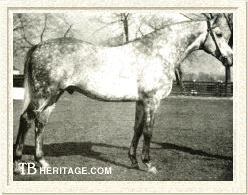
Royal Minstrel won the Craven and Eclipse Stakes, and was later sold to the U.S. as a sire.
| |
Golden Harp also produced three modest winners by lesser sires Grand Parade (Derby winner, sired a number of modest winners and one 2,000 Guineas winner), Gay Crusader (a triple crown winner who got winners, but was primarily influential as a broodmare sire) and Golden Myth (Ascot Gold Cup, Eclipse Stakes, also a disappointing sire). But her only other significant foal was Melpomene (1929, by Son-in-Law), who was purchased to the U.S., where she had an undistinguished and short racing career at age 3. Melpomene went on to produce six winners and became the ancestress of a number of top racers, including the good race filly Noodle Soup and her son, Needles (Kentucky Derby, Preakness). Golden Harp was also sold to America, soon after daughter Melpomene.
Harpsichord produced Gainsharp (1924, by Gainsborough), who won seven races worth over £1200; Havelock (1931, by Colorado), who the same amount in four races and a dead heat, and Hairan (1932, by Fairway) who won five races and over £6,000, including the Dewhurst Stakes, Coventry Stakes and Sussex Stakes. Her top foals, however were the big grey colt Royal Minstrel (1925, by Tetratema), and the grey filly Qurrat-Al-Ain (1927, by Buchan), both by sires Maher tended to favor.
Royal Minstrel, a big, upstanding grey colt, was sold as a yearling at Doncaster for 4,200 guineas to Cecil Boyd-Rochfort, agent for owner Captain Gough, who at that same sale purchased a Maher-bred Wenchal-Phalaris colt for 5,200 guineas. Royal Minstrel proved to be a good, game runner, with a huge stride, beaten by a head into second place in the 2,000 Guineas, but winning the St. James' Palace Stakes at age 3, and the Eclipse Stakes (beating Fairway), and the Victoria Cup at age 4. Sent to the U.S. for stud duty, he got Bransome, the long-running First Fiddle, and other good stakes winners and producers; returned to Great Brtain in 1938, he died two years later.
Although by the mid 1920s, the Aga Khan had scaled back somewhat on his purchases at the major yearling sales, both in Britain and France, when Maher's 1927 grey filly, a half- sister to Royal Minstrel, came up for auction at the 1928 Doncaster sale, she was snapped up for his stable, a sales-topper at 12,500 guineas, more than 2,500 guineas more than he paid for Mumtaz Mahal in 1922. Named Qurrat-Al-Ain, which means "Apple of my eye"--she surely was, winning three races of six at 2 (and placing twice), including the Queen Mary Stakes. At age 3 she won the Coronation Stakes and placed second in the July Cup, showing she could win sprints as well as middle distance races.
|
Retired to the stud, she bred seven foals, all winners, with daughters Majideh and Queen of Shiraz winning the Irish 1,000 Guineas and Irish Oaks respectively. Grandaughter Masaka (Nearco-Majideh) also won the Queen Mary Stakes and then went on at age 3 to win both the Oaks Stakes at Epsom and the Irish Oaks Stakes. Another Majideh foal, Gallant Man, sold to America, won the Belmont Stakes and the Jockey Club Gold Cup, among other top races and became a good broodmare sire. Qurrat-Al-Ain is seen in the pedigrees of good racehorses around the world.
The Tale of Waffles and Her Classic Sons
At the 1913 December Newmarket sale Maher purchased Lady Mischief, a ten year old brown mare, in foal to Dark Ronald, for 620 guineas, which was almost the exact average sales price for broodmares at that sale. She had placed in two of her nine starts at age 2, ran without success three times at age 3, and had produced no winners, when put under the hammer. However, her pedigree was attractive to Maher. She was by the leading sire, St. Simon, and her dam, Vain Duchess (1897, by Isinglass), had been a solid winner of four races at the age of 2, including the Newmarket Breeders' Plate and Doncaster's Rous Plate, and had won the Duchess of York Stakes at York at age 3. Her second dam, Sweet Duchess (1891, by Hagioscope) was a good race filly, winner of the Doncaster Cup, and second in the Epsom Oaks Stakes. Lady Mischief's half-brother, Helicon (best known today as the sire of Helene de Troie), had won and placed in some moderate races, including the Hastings Plate, by the time Lady Mischief was sent to Newmarket.
|
| LADY MISCHIEF 1903 by St. Simon |
| LADY LACHINE 1914 by Dark Ronald |
RABONA 1920 By Roi Herode
Won £2,700 at 2; producer |
ALGONQUIN 1928 by Gay Crusader
Sold for 9,000 gs, won £2,410 |
RATHCARRON 1924 By Lemberg
producer |
HILL CAT 1928 by Marten
Won £6,376 |
STRATHCARRON 1930 by Tetratema
Won £4,465 |
SILK MIST 1931 by Phalaris
Winner at 2 and 3; producer |
| WAFFLES 1917 by Buckwheat |
BUNWORRY 1921 by Great Sport
Curragh Juvenile Stakes and others; producer |
SAUCY SILVER 1927 by Silver Image
grandam Burma Road |
BENVENUTA CELLINI 1928 by Craig An Eran
producer |
BERNINA 1931 by Pharos
Italian Oaks, Premio Parioli and others; Ancestress Balestrina, Barbara Sirani, Botticelli, Braque |
BRUGHEL 1932 by Pharos
8 wins in Italy; leading sire in Australia |
BOZZETTO 1936 by Pharos
Premio Duomo and others; 3 times leading sire in Italy |
MANNA 1922 by Phalaris
Epsom Derby, 2,000 Guineas; sire |
PARWIZ 1925 by Phalaris
City and Suburban HC; sire |
SANDWICH 1928 by Sansovino
St. Leger ; sire |
WAFER 1934 by Sansovino
minor placegetter; dam of Hoylake, Manetta |
|
Bold type indicates the horse was bred by J.J. Maher.
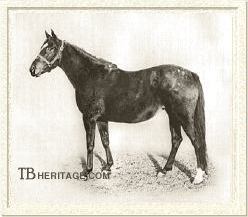
The excellent Maher-bred matron, Waffles.
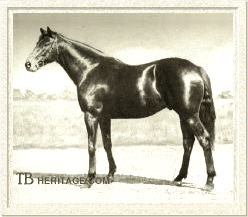
Maher-bred Derby winner, Manna, from Waffles by Phalaris.
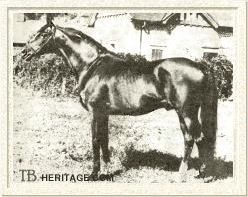
Parwiz, brother to Manna, was not quite up to classic level, but still won some good races. Sold to Argentina, where he became a good sire.
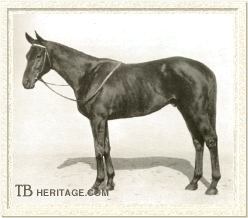
Mannamead (1929, Manna - Pinprick by Torpoint), bred by Lord Astor, was the unbeaten winner of 7 races, including the Clearwell Stakes and the Autumn Foal Plate at Doncaster. Later exported to Hungary where he was a leading sire.
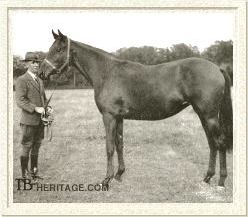
Mannetta (1943, Nearco-Wafer), a Waffles grandaughter bred at Confey after Maher's death, was the top selling filly at the 1944 substitute Doncaster yearling sales at Newmarket.

Bred to go a distance, Waffles' second classic son, Sandwich, was by Derby winner Sansovino.
| |
On Manna's St. Leger Race:
"You saw him canter to the post with beautiful precision of action, the acme of idea movement in the thoroughbred horse. The next picture showed him toiling far down the beaten, straggling line that followed Solario home. As the colt passed out from public view for the last time many of us saw him limping like a tired old hound with thorns in his pads. The sight cleared away the mist of wonder that he should have performed so ingloriously. He had come to Doncaster two days before as fit as any horse could possibly be, trained to the minute, and tried over a severe mile and three-quarters at Beckhampton to stay the St. Leger distance beyond a shadow of doubt...Two days after the race it was with difficulty he could hobble his way into a horse ambulance, to be conveyed to the station at Doncaster for entrainment back to Beckhampton."
--"Hotspur." Daily Telegraph, 1925.
| |
| |
The brown Lady Lachine was the Dark Ronald foal Lady Mischief dropped in 1914. At age 3 she won a £500 race at The Curragh, and Maher retained her for the Confey Stud. Lady Mischief bred two other modest winners, Caughnawaga (1916), by Llangibby, the leased stallion he had at Confey, and Scapin (1920), by Louvois, the other stallion Maher stood at Confey for a few years.
Lady Lachine produced two winners, both by Roi Herode. Pilate (1924) won a small race worth £256. Lady Lachine's daughter, Rabona (1920, by Roi Herode), won three races and dead-heated one at age 2, earning a total £2,642 (including the Phoenix Park Plate) for Maher, who kept her for Confey, and bred two winners from her: Regained (by Gainsborough), and Algonquin (1928, by Gay Crusader), who Maher sold for the considerable sum of £9,000 at the yearling sales, and who won his owner, Lord Beaverbrook, £2,410 in his only race at 2. In 1931, he sold Rabona at the Ballsbridge, Dublin, sale, for 25 guineas. Maher also bred Lady Lachine to Derby winner and one-time leading sire Lemberg, producing the filly Rathcarron in 1924. She was also kept in the Confey Stud, where she produced four winners: Hill Cat (1928, by Marten); Strathcarron (1930, by Tetratema); Silk Meadow (1931, by Phalaris, winner of £500 at age 2 and a small race at age 3, retained for the Confey Stud); and Sunnybank (1935, by Solario, winner of a £500 race at age 2).
Lady Lachine and her offspring were all "leggy," as Maher put it, which they evidently inherited from Dark Ronald (sire of Son-in-Law and leading sire five times in Germany after export). Maher was looking for a "short-legged, stuffy" filly, so in 1916 Lady Mischief was sent to Buckwheat (1906, by Martagon), "...one of the most perfectly-made thoroughbreds ever seen." He was a decent handicapper who had won £4,245, including the Duke of York Stakes, and was standing for £48; he had a reputation for getting small, "but roomy" stock. Corn Sack, a winner of the City and Suburban, and Royal Bucks, a winner of the Lincolnshire Handicap, were both by him; he was later sent to Australia, where he got nothing of note and died in 1924. Because his dam, Sesame, was by St. Simon, he also brought a second close-in line of St. Simon to the future foal's genetic make-up. Maher got what he wanted, a small, thick-set filly he named Waffles, bred 3 x 2 to St. Simon. She was not raced, and was left to pasture at Confey; at maturity she barely reached 15 hands.
When age 3, Waffles was bred to Great Sport (1910, by Gallinule), a son of the long-running racemare Gondolette (1902, by Loved One), who was enroute to becoming one of the most influential mares in thoroughbred breeding. Maher was to return to another Gondolette son, Sansovino (1921, by Swynford), with Waffles at the end of the 1920s. Great Sport was a moderate racehorse, who had won the Rous Stakes, among others, and placed third in the notorious "Suffragette Derby."
The resulting Waffles-Great Sport foal was Bunworry (1921), a strong, speedy filly who won four races for Maher at age 2, including the Curragh's Juvenile Stakes. Deemed too small for even Maher to keep, she was sold to India; in 1926, on the heels of her half-brother Manna's successes, she was brought back to Ireland, and in 1927 dropped a filly, Saucy Silver (by Silver Image, a grandson of Sterling Balm) who became the dam of American Grand National winner Burma Road. In 1928 Bunworry was purchased to Italy for the goodly sum of 2,600 guineas. At Federico Tesio's stud there she produced Bernina, who won three Italian classic races and was grandam of Botticelli (Ascot Gold Cup, sire); Bozzetto, a three time leading sire in Italy; Brueghel, winner of Italian races and leading sire in Australia.
In the meantime, the first crop by Phalaris (1913, by Polymelus), easily the most influential thoroughbred sire of the first half of the twentieth century, had become yearlings. A good handicapper who won sixteen races over mostly sprint distances during the war, Phalaris had retired to stud in 1919, and it appears Maher, like other savvy breeders, had already marked him as a potential top sire--Maher was to send at least one mare each year to Phalaris until the horse's death in 1931. But all of Phalaris' promise was still to be realized when Maher sent Waffles to Phalaris in the spring of 1921. In fact, it was Manna, the colt foal resulting from that breeding, that catapulted Phalaris into the top of the leading sires list for the first time, in 1925.
The reasons Maher sent Waffles to Phalaris, at least those he recounted to the editors of the Bloodstock Breeders' Review, were that Phalaris was a "big upstanding horse, with great speed, and a pedigree that seemed to make him an ideal mate." With Bunworry a tiny replica of her dam's size, it seems likely Maher wanted to get some size on the next foal, and Phalaris had proven fast, durable (running to age 5), and a weight-carrier. Still, there was nothing to indicate at that time, even to Phalaris' owner, the Earl of Derby, that he would be capable of getting horses that could stay a classic distance. The other attraction Phalaris held was his pedigree: a cross with Waffles would give the foal two lines of Isonomy (through both sire and dam), a top class race horse who did not run in the classics. There would also be two lines of Hampton through sire and dam; Hampton won some good races in his five seasons on the turf and sired three Derby winners among his many other good offspring. And, Phalaris brought in another line of St. Simon.
Manna was a lovely yearling, the Breeders' Review survey noting: "There must be very few among those who saw all the yearlings sold at Doncaster who will question the assertion that the first prize for looks was due to Mr. J.J. Maher's bay colt by Phalaris out of Waffles...It would be difficult, probably impossible, to find fault in this colt. Praise of him may be summarised by stating he is a superb creature. That he gets his lovely quality from Buckwheat, as well as from Phalaris, may be safely assumed. If he combines the racing merits of those two horses, well and good for Mr. H.E. Morriss, on whose behalf Fred Darling bought him for 6,300 guineas."
Morriss was a wealthy bullion broker in Shanghai who began to dabble in thoroughbreds in 1913, but by the time of the 1925 2,000 Guineas, which Manna won with ease, Manna was his only horse. Manna also won the Derby that year, by eight lengths, setting aside concerns about his ability to stay that distance. He then came third to an honest win by Solario in the Ascot Derby, and rumors of his staying ability began to surface again. Manna came in tenth in the St. Leger, although the odds-on favorite for the race that would have made him the Triple Crown winner, and at the end of the race he came off the track lame. Later it was determined he had sprained his knee, probably in the moments before the race even began, when his jockey for all three races, the famous Steve Donoghue, had to pull him up sharply to prevent a mishap enroute to the starting post.
At stud Manna got Colombo, a 2000 Guineas winner and never out of the money, later a classic sire himself; the unbeaten Mannamead, later sent to Hungary as a sire; Manitoba, a champion sire in Australia; Pasca, grandam of 1953 Derby winner Pinza, and other good horses.
|
Waffles was sent without result to The Tetrarch in 1922, and, bred to his sire, Roi Herode, in 1923, produced a colt purchased as a yearling by Sir Victor Sassoon, but sent to India after proving to be a non-winner in Britain. Waffles returned to Phalaris in 1924, and the result of that match was Manna's brother, Parwiz, who looked very similar to his brother, albeit a bit taller. He was bought by the Aga Khan at the Doncaster yearling sale for 10,000 guineas. He did not run in the classics, but was a good winner (£3,917) of the Gratwicke Stakes and the City and Suburban Handicap, and was third, ironically, to Maher-bred Royal Minstrel, in the Eclipse Stakes. The Aga Khan did make his initial investment back when Parwiz was sold to Argentina in 1929 for 20,000 guineas, where he was especially successful as a broodmare sire. He got Killarney (1936, from Kitty Ricks), the top 2 year old of his generation in Argentina; and good winners such as Michel (1938, from Dona Chela), Encantador (1937, from Energy; later a top sire in Chile), Okay (1934, from Orange Flower), and Palanca (1932, from Pontezuela), the best mare of her year in Argentina.
Following two barren seasons, Waffles was bred to Sansovino, another son of the great broodmare Gondolette, whose son, Great Sport, had produced the well-traveled Bunworry, Waffles' first foal. A son of St. Leger winner Swynford, who led the sire list in 1923, Sansovino (1921) was a Derby winner who won six races at ages 2 and 3, for a total of £17,732. Sansovino's best offspring included Jacopo, a good sire in the U.S., and Sansonnet, the dam of Tudor Minstrel. The Waffles-Sansovino cross brought more elements of stamina to the resulting foal's pedigree than the Waffles-Phalaris cross did. Sandwich, born in 1928, proved to be an ideal mix of speed and staying power. He was sold as a yearling to Lord Rosebery for 3,600 guineas, who sent him to trainer Jack Jarvis at Newmarket. He ran once, unplaced, at age 2. At age 3, he ran fifth in the Craven Stakes, then ran almost last in the 2,000 guineas, but six days later won the Chester Vase ( 1 and 1/2 miles). In the Derby he went off at odds of 8 to 1, and came in third, trailing the winner, Cameronian by 1 1/2 lengths, but closing fast in the final stretch, and many thought had the race been another half furlong in length, he would have won it. He went on to win the King Edward VII Stakes (12 furlongs), and then came his St. Leger win, by four lengths, again coming from behind, as was his style. Sandwich did not produce much of value in the stud.
Waffles was barren to Phalaris in 1929, and then was bred to Derby winner Spion Kop, a son of Spearmint and Hammerkop, a daughter of Gallinule. Spion Kop got a Derby winner and two good sire sons, but the Waffles foal, Tuppence, who was the top-priced yearling in the Doncaster sale held two days after Sandwich's 1931 St. Leger win (6,600 guineas to Dorothy Paget, best known as the erratic owner of the top 'chaser Golden Miller) never won a race and was later sent to Russia.
Waffles' last foal of note was Wafer, a sister to Sandwich, born in 1934. She ran six times at ages 2 and 3 in Ireland, placing in the Anglesey Stakes, and two minor races at age 3, although by then Maher was dead. Still, as the only Waffles daughter available and useful, she was retained for the Confey Stud by Maher's wife, who continued to breed horses into the 1940s. Wafer produced Hoylake, a son of Fairway, who won £1734. Through her non-winning daughter, the bay Manetta (1943, by Nearco), she was the granddam of Gazpacho (1960, by Hard Sauce), a winner of the Irish 1,000 Guineas, and later the dam of winners both over obstacles and on the flat. Manetta was one of five yearlings sold by Maher's wife for Confey Stud at the wartime Newmarket substitute for the Doncaster sales in 1944. Manetta was the top priced filly to sell, at 8,200 guineas, to Mrs. Philip Hill. The 1944 sale marked a brief resurgence in Confey Stud success, which had "...suffered a temporary eclipse" after the death of Maher; five yearlings were sold for an average price of 4,866 guineas.
Other Maher Mare Tales
Maher owned and bred mares other than those noted above, of course, but not too many more. Of these, the more immediately successful producer was Mukden (1909), by Mauvezin (winner of the Goodwood Steward's Cup, poor sire), from the mare Missovaja (1901, by Chesterfield, won two stakes races at age 2 and was a producer of stakes winners), who was bred by Lord Carnavon, and purchased by Maher. Mukden ran unplaced in her six starts at age 2, and bred only two modest winners in Great Britain for Maher, Louvasia by Louvois (1921), and the chestnut filly Dorval, by John O'Gaunt (1916).
Maher kept Dorval after her brief racing career at age 2, when she won two small races. Her sire, John O'Gaunt (1901), had won only one race, but had gotten the champion sire and St. Leger winner Swynford (1907) and some other classic winners before falling into sire obscurity, and he himself was bred in the purple, son of Triple Crown winner Isinglass and the stellar classic winning mare, La Flêche. From her, Maher bred four winners, Roidore (1922, by Roi Herode), Doushka (1923, by Tetratema), Spiral (1928, by Spion Kop), and Wilden Hill (1932, by Soldennis).
The grey colt Roidore sold as a yearling at Doncaster for 1,200 Guineas, and went on to win £5,833 at the handicap level. As a sire, he got sisters Bray View (1937) and Braydore (1935), from Bray Beauty. Bray View is ancestress in tail-female descent of such horses as the unbeaten two year old Elmaamul (1987, Diesis - Modena), and his half-sister, Reams of Verse (1994, Nureyev - Modena), and of Zafonic (1990, Gone West - Zaizafon), champion two year old in France and England. Braydore was the dam of the Wood Memorial Stakes winner and sire, Correlation (1951, by Free America). He also sired some good jumpers, including Roimond, second in the 1949 Grand National.
Doushka won £3,038; her wins included the Yorkshire Oaks, where she beat the classic winning filly Short Story; in the stud she produced five winners of modest races, her best youngster being the filly Snow White (by Colombo), who ran for three years, later grandam of Nordlys (1951) by Nasrullah. Spiral, whom Maher retained and raced, was a good race filly who won the Beresford Stakes, her only race at age 2, and went on at age 3 to easily win the Irish 1,000 Guineas at The Curragh, but failed to place subsequently in the Irish Oaks; she was a disappointment at stud, producing one very modest winner.
Another good producer Maher bred was Confey, born in 1916, by Polymelus. Her dam, Strathvaich (1908), was by Ascot Gold Cup winner Love Wisely, and out of Salvaich (1896), dam of the great 'chaser sire, My Prince. Polymelus was a good runner and a champion sire five times, who got Phalaris and a number of classic winners--his dam, Maid Marian, was half-sister to La Flêche, in the pedigree of Dorval, mentioned above. Strathvaich produced three winners for Maher; the foals from Llangibby and Louvois won a few small races. Maher kept Confey, and sent her to race at age 2, as he did with most of the fillies he retained for his stud; she won two races in Ireland worth £1496, by far the most successful of her dam's produce. Confey went on in Maher's stud to produce seven winners. A colt, Oojah (1922), by Bachelor's Double, brought 1650 guineas at Doncaster's yearling sales, and won £3,563. One of his descendants was exported to Australia as a sire. A daughter, Confetti (1927), by Tetratema, won two races worth £1546, and was a modest producer. Confey was also the dam of the useless Fête, purchased by Sir Victor Sassoon the record breaking price of 12,000 guineas in 1925.
|
|

